The Carrizo Trail is a historic route, used in the 1800’s by homesteaders driving their cattle and hogs to market in Jolon. After the construction of coastal highway it fell out of use but was later re-created by Steve Chambers and other VWA trailworkers, to connect the coastal ridge to the San Antonio River. But where exactly does it go? And where is the USFS “Carrizo Spring Camp” which lies along it?
The above interactive map displays the routings found on a USGS quadrangle map (in black), from the 2009 USFS database (in red), and from Garmin MapSource (in blue). (I found other route variants in Delorme and TOPO! software, but for simplicity will ignore those.) While they roughly follow the same route there are significant differences.
Having encountered a mis-mapping at the upper end of the Carrizo Trail [see “Maps can lie” post], I became interested in finding out where the Ventana/SilverPeak wilderness area trails really went. Locating the actual Carrizo Trail seemed like a good place to start, since it had different routings on different maps. Which, if any, of those was correct?
I needed to GPS the trail myself to find the actual route, so a sunrise found me at its east end, wondering how far I would get. Not being familiar with Ventana wilderness trails at the time, I did not know what to expect. I soon found the initially apparent tread disappearing and had to start looking for trail signs, so progress slowed. On occasion I found a faded flag, which greatly helped, but still I “lost” the trail six times before reaching the ridge (first saddle), each time having to search to re-find it.
Beyond the ridge, the trail descended into a “brushbowl” which was much overgrown, a consequence of being far from both trailheads and difficult for trailcrew to reach. My speed slowed significantly, often having to crawl below interlocked branches. Still, the tread was generally evident and I only “lost” it twice before reaching the next ridge (second saddle).
Beyond that lay Sugar and Coulter Pine trees with little underlying brush and an apparent tread so my pace quickened – good thing, since I was running out of time. Finally, 5.4 miles and 6 hours after I started (0.9 mph average), I reached a point which I had previously accessed from the other direction on my “Maps can lie” hike. The Carrizo Trail had been mapped!
With only with only 4 hours til sunset, I had to push on my return. But it was downhill and familiarity with the route helped – my descent route turned out to be 0.5 miles shorter than my ascent route. I arrived back at the trailhead just as light was fading.
Sorry, no photos to display – all my time was spend trying to follow the trail. [For photos, see a later Carrizo Trail hike].
You can use the interactive map below to compare the actual Carrizo Trail route (in green) with the USGS, USFS, and Garmin mappings. [You will need to zoom in to see details.] The USFS route displays some wild swings and in several places is obviously incorrect – no trail would make such small-scale elevation up-and-down excursions. The USGS and Garmin routings are better – at least their shape is reasonably correct. But in many places their error is so large that loaded in a GPS it could lead a hiker in the wrong direction should he lose the trail and become lost in the brush – the GPS would “lie” to them.
Interactive map: Actual trail (green) vs USGS (black) vs USFS (red) vs Garmin (blue)
Pushpins: Actual Carrizo Spring Camp (green) vs USFS map (red) vs USFS database (yellow)
(Click here for full-size interactive map)
Finding the actual location of Carrizo Spring Camp also proved interesting. Before the hike I had camp locations obtained from the official USFS database (yellow pushpin on map), from a special USFS quadrangle map (red pushpin on map), and from a few other sources. Yet I found that none of those matched the actual location (green pushpin on map)! The USFS database error was particularly surprising because it was supposed to be a GPS’d location – but it was nearly two trail miles from the actual location! Someone had a GPS but not any knowledge of where the camp actually was (as marked by remnants of an icemaker stove). The USFS quadrangle location was “only” off by half a trail mile.
All in all, a rewarding start to my venture of finding the true locations of Ventana trails.
